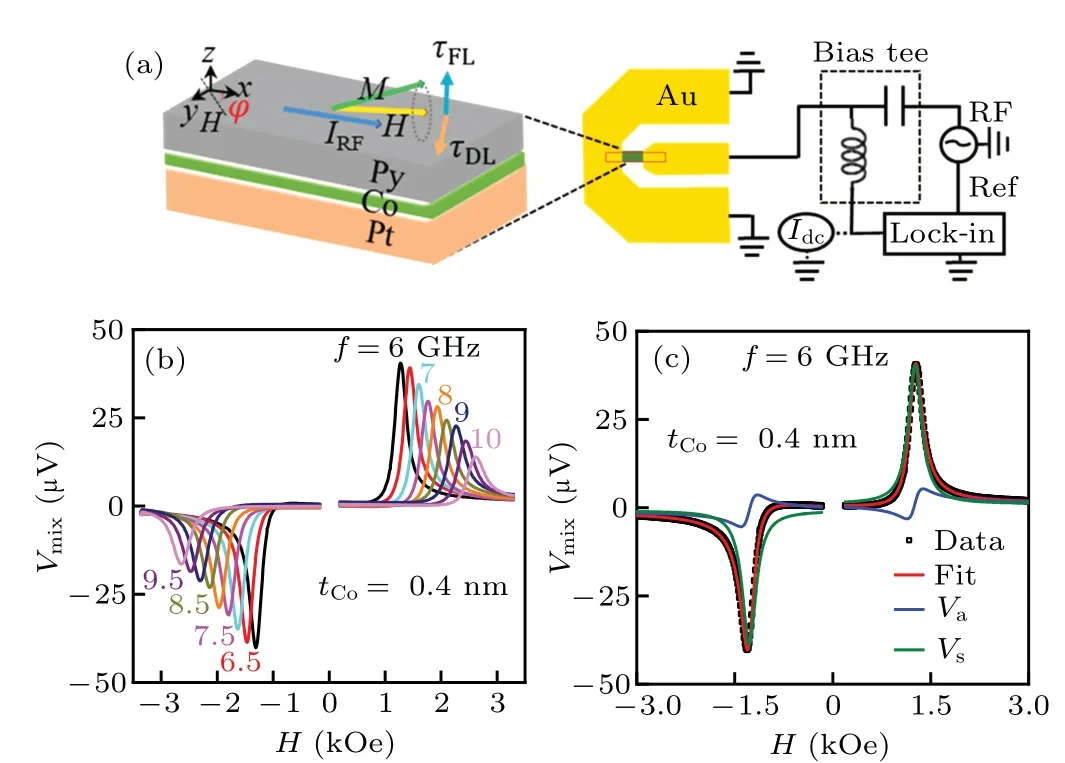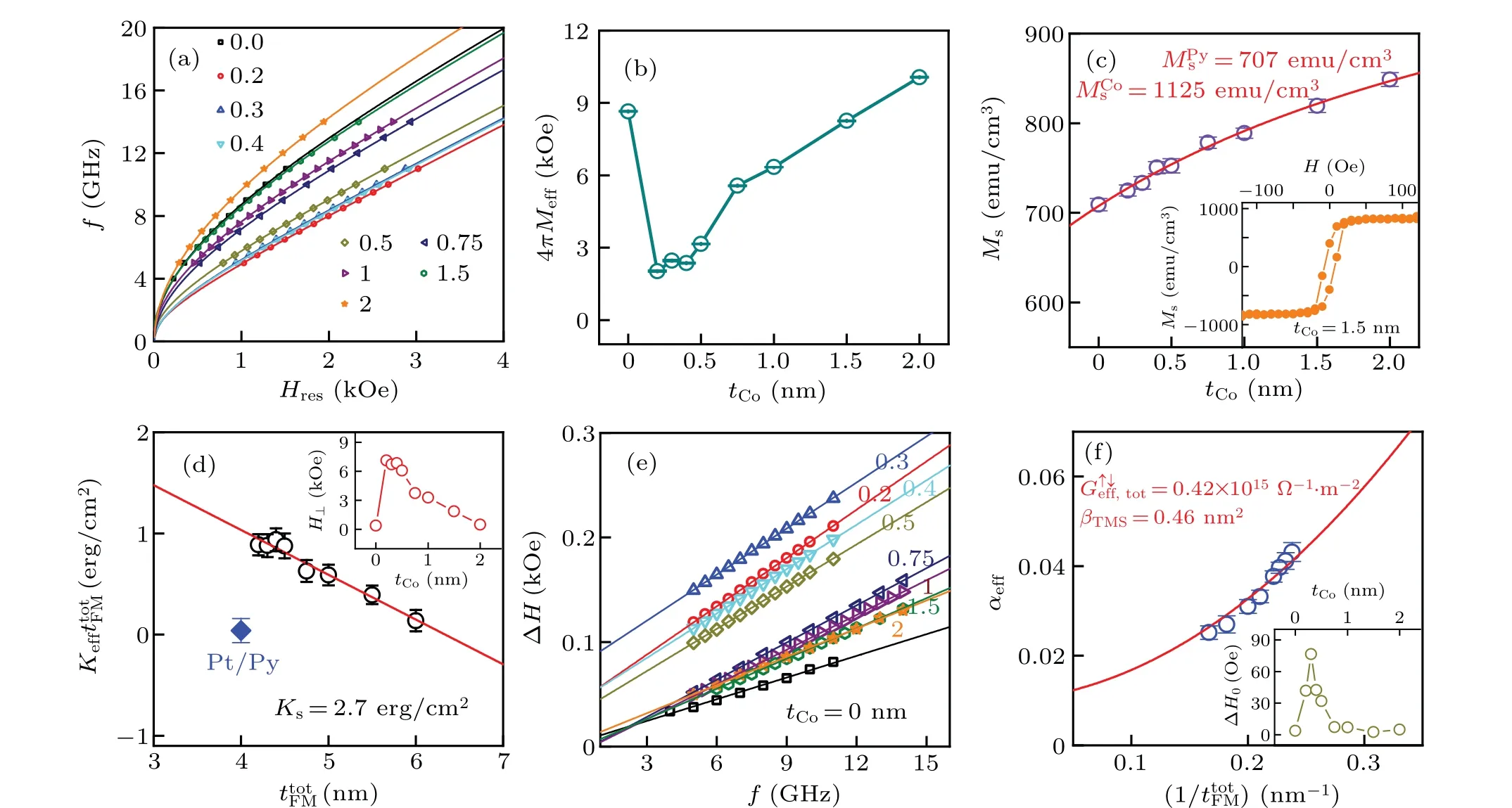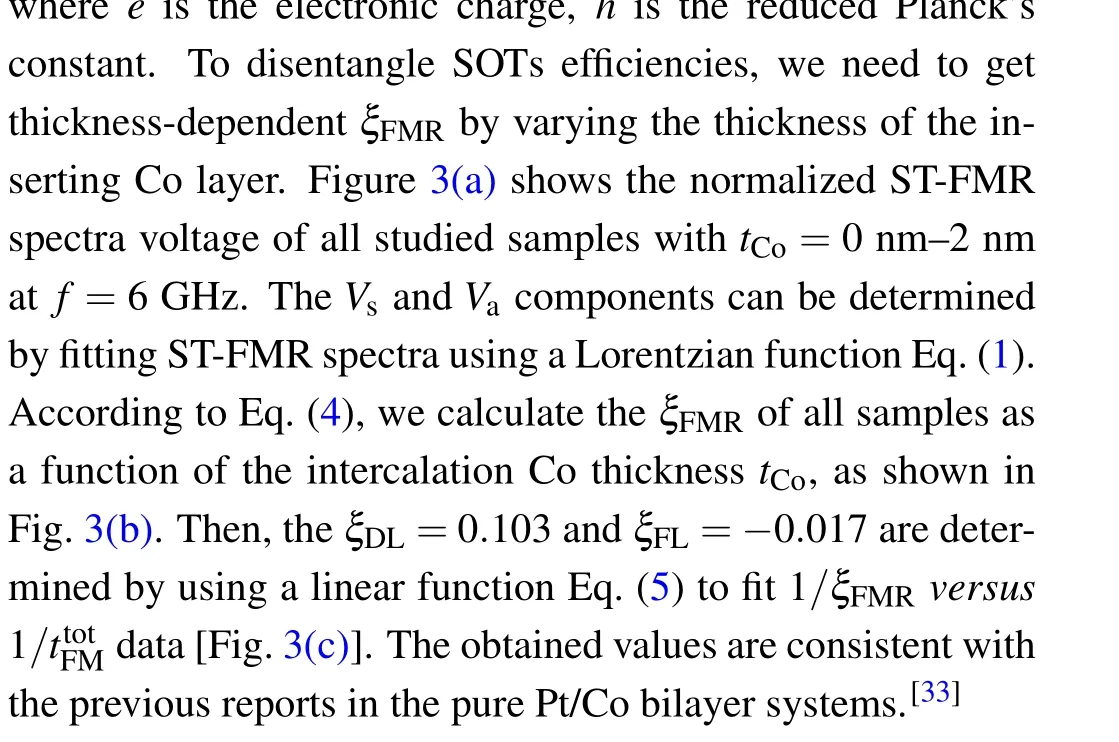Enhancement of spin–orbit torque efficiency by tailoring interfacial spin–orbit coupling in Pt-based magnetic multilayers
2022-09-24WenqiangWang王文强GengkuanZhu朱耿宽KaiyuanZhou周恺元XiangZhan战翔ZuiTao陶醉QingweiFu付清为LikeLiang梁力克ZishuangLi李子爽LinaChen陈丽娜ChunjieYan晏春杰HaotianLi李浩天TiejunZhou周铁军andRonghuaLiu刘荣华
Wenqiang Wang(王文强) Gengkuan Zhu(朱耿宽) Kaiyuan Zhou(周恺元) Xiang Zhan(战翔) Zui Tao(陶醉)Qingwei Fu(付清为) Like Liang(梁力克) Zishuang Li(李子爽) Lina Chen(陈丽娜)Chunjie Yan(晏春杰) Haotian Li(李浩天) Tiejun Zhou(周铁军) and Ronghua Liu(刘荣华)
1National Laboratory of Solid State Microstructures,School of Physics and Collaborative Innovation Center of Advanced Microstructures,Nanjing University,Nanjing 210093,China
2New Energy Technology Engineering Laboratory of Jiangsu Provence and School of Science,Nanjing University of Posts and Telecommunications,Nanjing 210023,China
3Centre for Integrated Spintronic Devices,School of Electronics and Information,Hangzhou Dianzi University,Hangzhou 310018,China
Keywords: spin-orbit torque, interfacial Rashba-Edelstein effect, spin-torque efficiency, spin-torque ferromagnetic resonance
1. Introduction
Spin-orbit torques(SOTs)[1-8]in heavy metal/ferromagnet(HM/FM) systems have become a powerful approach to achieving a pure current control of magnetization switch for building an energy-efficient SOT-magnetoresistive randomaccess memory (SOT-MRAM)[9]and excitation of coherent spin waves for magnon-based logic devices[10,11]or spin synchronization-based neuromorphic computing.[12-14]
The generation of SOTs originates from the orbital angular momentum transferred from the lattice to the spin system due to the spin-orbit interaction in the HM with strong bulk spin-orbit coupling (SOC) or/and at the HM/FM interface with strong interfacial spin-orbit coupling (ISOC). The former is generally described as the spin Hall effect (SHE),and the latter is commonly known as the interfacial Rashba-Edelstein effect(IREE).[15]As shown in Fig.1(a),SHE/IREEgenerated in-plane (IP) transverse polarizationσyspin currents exert two types of SOTs on the magnetizationmof the adjacent FM layer: one is the IP damping-like (DL)torque[1,16]τDL=τDLm×(σ×m);and the other is the outof-plane (OP) field-like (FL) torque[17]τFL=τFL(σ×m).Previously many theoretical studies have revealed that the DL torque originates predominantly from the SHE,[18]while the FL torque is dominated by IREE.[15]However, many recent FM thickness-and interface-dependent SOTs efficiency experiments found that the IREE can also significantly contribute to the DL torque with a value comparable to SHE-contribution in some HM/FM systems with strong ISOC. In addition, the interface-related spin memory loss(SML)and spin flow back also play an essential role in the effective SOTs efficiencies.For instance, the SOTs efficiencies can be significantly enhanced by improving interfacial spin transmission efficiency and enhancing IREE via interface engineering,such as inserting ultrathin nonmagnetic metal layer(e.g.,Hf,[19]Mo,[20]and Cu[21,22])between the HM and FM layers,oxygen-induced interface orbital hybridization,[23]alloy,[24]and interfacial H+and O2-ion manipulations.[25]Very recently,inserting a magnetic spacer[26,27]between the FM and HM layers has also been proposed as a promising method to improve the effective SOTs efficiencies by selecting suitable magnetic materials to increase ISOC and/or enhance interfacial spin transparency(Tint).[26]However,the detailed characterization of the ISOCrelated interfacial magnetic properties,e.g.,interfacial perpendicular magnetic anisotropy (IPMA) energy density,[19]Tint,two-magnon scattering(TMS)coefficient,[28]the conventional SHE/IREE-induced DL torque efficiency(ξDL)and FL torque efficiency(ξFL)and possible unconventional SOTs of spin currents with OP spin polarization in Pt-based multilayer systems with a strong ISOC still remains a few so far.
In this paper,we study the SOTs efficiencies in the Pt/Co(t)/Py trilayers with a strong ISOC at the Pt/Co interface by spin-torque ferromagnetic resonance (ST-FMR) technique and find a significant enhancement of theξDL= 0.103 andξFL=-0.017 in Pt/Co/Py system with an inserting Co layer compared toξDL=0.051 andξFL=-0.002 in the Pt/Py bilayer. The enhancement of SOT efficiencies is related to the IREE-induced additional SOTs at a robust ISOC Pt/Co interface by inserting an ultrathin Co layer between Pt and Py.In addition,these Pt/Co/Py trilayers also exhibit considerable OP spin-polarized SOTs, revealed by the IP angular dependence ST-FMR spectra. The results suggest that the ISOC of the Pt/Co interface plays a vital role in spin transport and SOTs-generation and can be an efficient approach to promote the conventional SOTs efficiency and generate unconventional SOTs for the development of non-volatility,low power,higher speed,and higher endurance spintronic devices.
2. Experiments
The ST-FMR devices consist of the stack structure:Pt(5)/Co(t=0,0.2, 0.3, 0.4, 0.5, 0.75, 1, 1.5, and 2)/Py(4),which are deposited on annealed Al2O3substrate with(0001)orientation by d.c magnetron sputtering at room temperature with Ar sputtering gas pressure of 5.1 mTorr and background base pressure of 2×10-8Torr(1 Torr=1.33322×102Pa).The film thickness in parentheses is in nm. A 2-nm-thick MgO is adopted to protect the multilayers from oxidation in air. The films are patterned into a 5 µm×8 µm rectangle stripe with two top electrodes of Au(80)for ST-FMR measurement using the combination of photolithography, electron beam lithography,and ion milling.
3. Results and discussion
Figure 1(a) shows the ST-FMR measurement setup,[29]where a radio-frequency (RF) current (IRF) is applied along the longitudinal direction of the stripe by connecting a signal generator,and a dc mixing voltage(Vmix),generated from rectification among the RF current, SOTs and Oersted fielddriven oscillating resistance due to anisotropic magnetoresistance (AMR), is recorded by a lock-in while sweeping an IP external fieldH. Figure 1(b) shows the representative STFMR spectra of Pt(5)/Co(0.4)/Py(4) sample with excitation frequency from 6 GHz to 10 GHz,IP angleφ=30°. The obtainedVmixcan be well fitted with a Lorentzian function[1,23]

whereVs,Va,ΔH,andHresare the magnitude of the symmetric (Vs) and antisymmetric (Va) Lorentzian components, the linewidth, and resonance field, respectively. The representativeVmixdata of the Pt(5)/Co(0.4)/Py(4)withf=6 GHz and its fitting curves are illustrated in Fig.1(c).

Fig.1. ST-FMR spectra of Pt/Co/Py. (a)Left: The illustration of the stack structure of multilayer,coordinate system,and SOTs-induced magnetization dynamics in the ST-FMR measurement.Right:the schematic diagram of the ST-FMR setup. (b)ST-FMR spectra of the Vmix of the Pt(5)/Co(0.4)/Py(4)sample for frequency f between 6 GHz and 10 GHz increased in 0.5-GHz step at an angle φ =30° between the magnetic field and current direction.(c)Representative ST-FMR spectrum obtained at f =6 GHz and its fitting curves using Eq. (1). Vs and Va correspond to the symmetric and antisymmetric Lorentzian components,respectively.



Fig. 2. Thickness-dependent magnetic properties of Py(5)/Co(tCo =0 nm-2 nm)/Py(4) system. (a) Dispersion relation curves between f and Hres (symbols)and the corresponding Kittel fittings(solid curves). (b)-(d)Dependence of the effective demagnetization field 4πMeff (b),and the saturation magnetization Ms(c)and the H⊥(Inset in panel(d))on the inserting Co layer thickness tCo,and the effective magnetic anisotropy energy in terms of KeffttotFM (d) on the total FM layer thickness ttotFM. Inset in panel (c): the representative magnetization curve of tCo =1.5 nm sample.(e) Linewidth ΔH versus resonance frequency f. The solid line is the linear fitting. (f) Damping αeff as a function of 1/ttotFM (symbols). Inset:dependence of the inhomogeneous line broadening ΔH0 on the inserting Co layer thickness tCo.





Fig.3. Thickness-dependent ξDL and ξFL. (a)The normalized ST-FMR spectra voltage of all studied samples with tCo=0 nm-2 nm at f =6 GHz(symbols)and the fitting results using Eq.(1)(solid lines). (b)The ξFMR of all films as a function of the interlayer Co thickness evaluated by the ratio Vs/Va. (c)The relation of 1/ξFMR versus 1/ttotFM and its linear fitting using Eq.(5)in the text. (d)ST-FMR spectra at different dc bias currents Idc with an IP angle φ =30° for the tCo=0.4 nm sample. (e)Linewidth as a function of applied dc bias current Idc in the case of IP angle φ =30°(black circles)and φ=210°(red squares)for the tCo=0.4 nm sample.The solid red lines are the linear fittings.(f)The inserting Co layer thickness tCo dependence of ξDL determined by the LWM method.


To further confirm the validity of the above determinedξDL, we also adopt an alternative approach to quantifyξDLbased on the LWM by dc current-induced DL SOT acting on the FM layer.[23]ξDLcan be extracted through dc current-dependent linewidth ΔHmeasurements by the following formula:[1,23]

whereRFMandRHMare the resistance of the total FM and Pt layers, respectively, andAcis the cross-sectional area of the Pt layer. Figure 3(d)shows the representative ST-FMR spectra at different dc bias currentsIdcat an IP angleφ=30°.The extracted current-dependent linewidth ΔHat two IP anglesφ=30°and 210°fortCo=0.4 nm sample atf=4 GHz were shown in Fig. 3(e). The obtainedξDLusing Eq. (6) exhibits a nearly constant value ofξDL≈0.10 for all inserting Co samples[Fig.3(f)],closing to 0.103 obtained by the aboveVs/Vamethod. TheseξDL=0.103 andξFL=-0.017 are significantly larger thanξDL=0.051 andξFL=-0.002 in the Pt/Py bilayer,[1]indicating that the ISOC at the interface Pt/Co plays a vital role in both generating SOTs and spin transmission discussed above.
Since the ST-FMR voltage signalVmixof our studied microscale device is mainly contributed by the rectification ofIRFandIRFinduced periodic magnetoresistance due to the AMR effect, and with a negligible inverse SHE voltage due to spin pumping, the IP angular dependence of theVaandVscomponents ofVmixis related to the combination of the angular dependences of the AMR and the generated spin currents and the current-induced Oersted field. The AMR exhibits the sinusoidal dependence on magnetization with a period of 180°,RAMR∝sin2φ. Considering the generated spin currents with all possible spin polarizations, we can derive the general formula for describing IP angular-dependentVaandVsof STFMR voltage as follows:[41,42]TheVa,ycorresponds to the OP torque arising from currentinduced IP Oersted field and the effective field due to the generated spin currents with spin polarization(σy)via SHE/IREE,andVs,yis attributed to the SHE/IREE-induced IP DL torque.TheVa,zandVs,zoriginate from the OP DL torqueτ⊥,DLand the IP FL torqueτ‖,FLgenerated by the spin currents with OP spin polarization(σz),respectively.TheVa,xandVs,xare correlated with the OP FL torque and IP DL torque due to the spin currents with spin polarization (σx) along the charge current direction(xdirection).

To explore the possible existence of unconventional SOTs arising from the spin currents withσzandσxexcept for conventionalσy, we perform the IP angular dependence of the ST-FMR spectra. Figures 4(a) and 4(b) show the IP angular dependentVaandVsand their fitting curves using Eqs.(7)and (8) for the representative sample of Pt(5)/Co(0.4)/Py(4)underf=6 GHz. The fitting parametersVa,xandVs,xhave the negligible small value compared toVa,y, indicating that the generated spin currents withσxare negligible. However,there exists a considerable value forVa,zandVs,z, which can be used to quantify the strength ofτ⊥,DLandτ‖,FLby directly comparingVa,zandVs,ztoVa,ybecauseVa,yis mainly proportional toIRF-induced Oersted field. Therefore,Va,z/Va,yandVs,z/Va,yrepresent the strengths of the OP DL and IP FL torques exerted by the generated spin currents withσz. Figure 4(c) shows that|Va,z/Va,y| and|Vs,z/Va,y| as a function of the inserting Co layer thickness for all studied samples exhibit a maximum attCo= 0.4 nm. At the same thickness,theH⊥also exhibits the maximum. The generated spin currents with the OP spin polarization are proportional to theH⊥,suggesting that the strong 3d-Co and 5d-Pt orbital hybridization at the Pt/Co interface can generate a considerable OP DL torqueτ⊥,DLto facilitate current-induced magnetization switching in the HM/FM systems without needing an assistant field.[43]However,in the previous theory reports,[44,45]several proposed possible mechanisms,e.g.,spin swapping,[44]spinorbit precession,[46]and/or spin anomalous Hall effect,[47,48]can generate these spin currents withσz, warranting further theoretical and experimental studies of the behind mechanism of interface dependence of thisσz-spin currents.

Fig.4. Unconventional SOTs with OP spin polarization in Pt/Co(tCo=0.2 nm-2 nm)/Py. (a)-(b)IP angular-dependent Va(a)and Vs(b)of ST-FMR voltage signal for a representative Pt(5)/Co(0.4)/Py(4)sample at f =6 GHz can be well fitted by the combination of three terms:Vysin2φcosφ (blue line),Vzsin2φ (pink line),and Vxsin2φsinφ (green line). (c)The absolute value of Va,z/Va,y and Vs,z/Va,y as a function of tCo.
4. Conclusion

Acknowledgments
Project supported by the National Natural Science Foundation of China(Grant Nos.11774150,12074178,11874135,and 12004171), the Applied Basic Research Programs of the Science and Technology Commission Foundation of Jiangsu Province,China(Grant No.BK20200309),the Open Research Fund of Jiangsu Provincial Key Laboratory for Nanotechnology, Key Research and Development Program of Zhejiang Province, China (Grant No. 2021C01039), and the Scientific Foundation of Nanjing University of Posts and Telecommunications(Grant No.NY220164).
猜你喜欢
杂志排行
Chinese Physics B的其它文章
- Characterizing entanglement in non-Hermitian chaotic systems via out-of-time ordered correlators
- Steering quantum nonlocalities of quantum dot system suffering from decoherence
- Probabilistic quantum teleportation of shared quantum secret
- Spin–orbit coupling adjusting topological superfluid of mass-imbalanced Fermi gas
- Improvement of a continuous-variable measurement-device-independent quantum key distribution system via quantum scissors
- An overview of quantum error mitigation formulas
